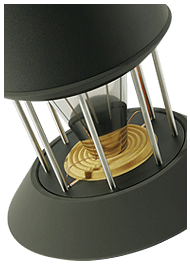PRODUCTS : LOUDSPEAKERS : DDD - Driver

THE DDD DRIVER
In 1978 Peter Dicks, engineer, mathematician and sociologist, was a very frustrated man. Dicks, who had no professional involvement in audio engineering at the time, had become fascinated with certain fundamental problems of audio transducer behaviour. After years of mathematical modelling and physical experimentation, he had created a design that he believed decisively surpassed the then state of the art. By 1980 Dicks had succeeded in developing an extremely impressive sounding working prototype based upon his innovative design concepts. He had also developed a complete theoretical model of the device’s operation. He expected these at the very least to elicit some degree of interest from the loudspeaker manufacturing industry. To his dismay, the numerous driver manufacturers he contacted throughout Northern Europe, all responded with either condescension or disinterest.
It was only in the early 90’s after a series of prototypes had been heard by a number of audiophiles that Dicks was finally contacted by a medium sized German company called Mainhattan Acustik They, in contrast to the rest of the European loudspeaker industry, showed the first real interest in his work. Mainhattan’s owner, Holger Mueller, was intrigued from the start. The prototype which Peter Dicks had developed was on the face of it a derivative of a design for which Mueller already had the highest regard, the famous Walsh Driver, invented by maverick American transformer engineer, Lincoln Walsh. Mueller himself owned a pair of Ohm F loudspeakers that used an early version of the Walsh driver and had always felt that the design had enormous untapped potential. As he examined the rather unimpressive looking prototype Dicks had presented to him, and pored over the detailed design notes, he realised that much of that potential had now been realised.
Mueller agreed to license the design, and thus German Physiks was born. The company’s first task was to turn Dicks’ prototype into a commercial product and for the next two years they pursued that task, patiently extracting every improvement in performance that the Dicks Dipole Driver, or DDD, as the new design was called, was capable of.
Not satisfied with superb laboratory measurements and the unbridled enthusiasm of his listening panels, Mueller initiated an exhaustive life testing program to ensure the absolute reliability of the driver under the most severe conditions of use. In parallel Dicks worked on fine tuning the math’s and the physical realisation, while Mueller worked on the aesthetics and a final industrial design, because he believed that the design of the driver must strongly express the company’s commitment to innovation through engineering and overall elegance of visual form.
Finally in 1993 the first production run was completed. The merits of the new loudspeaker were immediately recognised and accepted by both audio reviewers and audiophiles alike. The problems associated with conventional designs – cone break-up, directionality and phase anomalies – had been mathematically analysed and physically solved. The DDD driver works as a mechanical 4-way system. The lower frequency end of its operating range can be described with Small/Thiele resonant parameters; in the next frequency band up to the Coincidence Frequency, it works like a pistonic driver; next an overlapping band follows where pistonic movement is progressively replaced by bending waves until all radiation is generated purely by bending movement in the cone - due to dispersion and the cone’s special shape, the Coincidence Frequency is spread over an extended frequency range, rather than occurring at a single frequency like the Dipole Frequency; the last mode of operation commences above the bending wave band at the Dipole Frequency when the first standing wave occurs and where modal break-up begins. All 4 areas were mathematically described and then for the first time in history, the directivity pattern, break-up frequency and the frequency at which the diaphragm changes its mode of operation were calculated and used to find the ideal material and design to construct an optimised broadband acoustic driver.
German Physiks had combined high tech materials, precision manufacturing techniques and strict quality control procedures, with a genuine breakthrough in driver design, to produce a loudspeaker with outstanding transparency and resolution and most importantly exceptional musicality. The DDD driver and loudspeakers incorporating it, quickly won a number of major awards from leading audio magazines as the most advanced loudspeakers in the world.
Today German Physiks manufactures a range of loudspeakers that runs from state-of-the-art reference, to serious audiophile entry level and they are held in the highest regard by demanding audiophiles around the world.
The DDD Driver Specifications
| Titanium Cone | Carbon Cone | |
Sensitivity (without crossover) |
88.5dB for 1W at 1m | 88.8dB for 1W at 1m |
Impedance (without crossover) |
4 Ohms | 4 Ohms |
| Power Handling (without crossover) | ||
| Nominal Short term |
20W (120- 21,500Hz) 40W (120- 21,500Hz) |
50W (70 – 24,000Hz) 120W (70 – 24,000Hz) |
| Power Handling (with 12dB/octave crossover) | ||
| Nominal Short term |
60W (160 - 21,500Hz) 100W (160 - 21,500Hz) |
100W (160 - 24,000Hz) 180W (160 - 24,000Hz) |
| Power Handling (with 12dB/octave crossover) | ||
| Nominal Short term |
90W (260 - 21,500Hz) 120W (260 - 21,500Hz) |
120W (260 - 24,000Hz) 200W (260 - 24,000Hz) |
| Dimensions | ||
| Height (including diffuser) | 212mm 8.35” |
|
| Diffuser maximum diameter | 264mm 10.40” |
|
| Base plate diameter | 220mm 8.65” |
|
| Mounting hole location diameter | 190mm 7.50” |
|
| Weight | 6.3kg 13.9lb |
|





